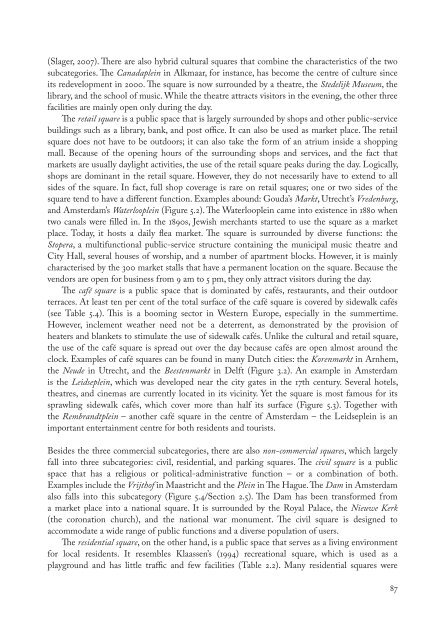Changing public space
Changing public space
Changing public space
You also want an ePaper? Increase the reach of your titles
YUMPU automatically turns print PDFs into web optimized ePapers that Google loves.
(Slager, 2007). There are also hybrid cultural squares that combine the characteristics of the two<br />
subcategories. The Canadaplein in Alkmaar, for instance, has become the centre of culture since<br />
its redevelopment in 2000. The square is now surrounded by a theatre, the Stedelijk Museum, the<br />
library, and the school of music. While the theatre attracts visitors in the evening, the other three<br />
facilities are mainly open only during the day.<br />
The retail square is a <strong>public</strong> <strong>space</strong> that is largely surrounded by shops and other <strong>public</strong>-service<br />
buildings such as a library, bank, and post office. It can also be used as market place. The retail<br />
square does not have to be outdoors; it can also take the form of an atrium inside a shopping<br />
mall. Because of the opening hours of the surrounding shops and services, and the fact that<br />
markets are usually daylight activities, the use of the retail square peaks during the day. Logically,<br />
shops are dominant in the retail square. However, they do not necessarily have to extend to all<br />
sides of the square. In fact, full shop coverage is rare on retail squares; one or two sides of the<br />
square tend to have a different function. Examples abound: Gouda’s Markt, Utrecht’s Vredenburg,<br />
and Amsterdam’s Waterlooplein (Figure 5.2). The Waterlooplein came into existence in 1880 when<br />
two canals were filled in. In the 1890s, Jewish merchants started to use the square as a market<br />
place. Today, it hosts a daily flea market. The square is surrounded by diverse functions: the<br />
Stopera, a multifunctional <strong>public</strong>-service structure containing the municipal music theatre and<br />
City Hall, several houses of worship, and a number of apartment blocks. However, it is mainly<br />
characterised by the 300 market stalls that have a permanent location on the square. Because the<br />
vendors are open for business from 9 am to 5 pm, they only attract visitors during the day.<br />
The café square is a <strong>public</strong> <strong>space</strong> that is dominated by cafés, restaurants, and their outdoor<br />
terraces. At least ten per cent of the total surface of the café square is covered by sidewalk cafés<br />
(see Table 5.4). This is a booming sector in Western Europe, especially in the summertime.<br />
However, inclement weather need not be a deterrent, as demonstrated by the provision of<br />
heaters and blankets to stimulate the use of sidewalk cafés. Unlike the cultural and retail square,<br />
the use of the café square is spread out over the day because cafés are open almost around the<br />
clock. Examples of café squares can be found in many Dutch cities: the Korenmarkt in Arnhem,<br />
the Neude in Utrecht, and the Beestenmarkt in Delft (Figure 3.2). An example in Amsterdam<br />
is the Leidseplein, which was developed near the city gates in the 17th century. Several hotels,<br />
theatres, and cinemas are currently located in its vicinity. Yet the square is most famous for its<br />
sprawling sidewalk cafés, which cover more than half its surface (Figure 5.3). Together with<br />
the Rembrandtplein – another café square in the centre of Amsterdam – the Leidseplein is an<br />
important entertainment centre for both residents and tourists.<br />
Besides the three commercial subcategories, there are also non-commercial squares, which largely<br />
fall into three subcategories: civil, residential, and parking squares. The civil square is a <strong>public</strong><br />
<strong>space</strong> that has a religious or political-administrative function – or a combination of both.<br />
Examples include the Vrijthof in Maastricht and the Plein in The Hague. The Dam in Amsterdam<br />
also falls into this subcategory (Figure 5.4/Section 2.5). The Dam has been transformed from<br />
a market place into a national square. It is surrounded by the Royal Palace, the Nieuwe Kerk<br />
(the coronation church), and the national war monument. The civil square is designed to<br />
accommodate a wide range of <strong>public</strong> functions and a diverse population of users.<br />
The residential square, on the other hand, is a <strong>public</strong> <strong>space</strong> that serves as a living environment<br />
for local residents. It resembles Klaassen’s (1994) recreational square, which is used as a<br />
playground and has little traffic and few facilities (Table 2.2). Many residential squares were<br />
87




